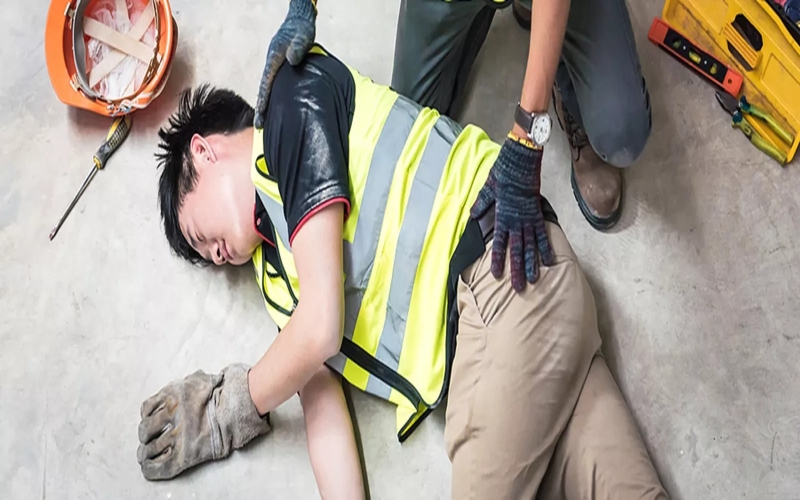Hazards are present everywhere, from office environments to construction sites, and pose a serious risk to employees’ health and safety. Understanding these hazards is the first step in creating a safer work environment. This blog explores common workplace hazards and strategies to avoid them.
What are Workplace Hazards?
Workplace hazards are any potential danger that can threaten employees’ safety, health or well-being within a work environment. These can range from physical injuries to psychological stresses. Recognising these hazards is crucial for preventing workplace accidents and ensuring a healthy work culture.
10 Common Workplace Hazards
- Slips, Trips and Falls: These incidents often occur due to neglecting safety measures such as cleaning spills, securing rugs and organising cables. Proper maintenance and awareness can significantly reduce these common yet preventable accidents.
- Electrical Hazards: Faulty wiring, overloaded circuits and damaged electrical equipment in the workplace can cause electric shocks, burns and fires. Avoiding overloading circuits, replacing damaged electrical equipment and providing electrical safety training can help prevent the risk of electrical incidents.
- Hazardous Substances: Exposure to chemicals, fumes, dust and other hazardous substances can cause respiratory issues, skin irritation and other health problems. Proper ventilation systems, protective equipment and online COSHH training can help minimise these risks.
- Ergonomic Hazards: Incorrect chair height, poor desk setup and repetitive movements can result in long-term injuries. Proper ergonomic assessments and setups can help create a more comfortable and productive working environment.
- Fire Hazards: Neglecting simple safety measures like clear evacuation paths and proper storage of flammables can lead to devastating outcomes. Regular fire drills and safety training can heighten awareness and preparedness.
- Biological Hazards: Employees are often exposed to infectious materials in sectors like healthcare and waste management. Implementing standard infection control practices can safeguard their health.
- Noise Pollution: Continuous exposure to high noise levels can impair hearing over time. Providing hearing protection and designing quieter workflow processes can help mitigate this risk.
- Physical Hazards: Working in extreme conditions without appropriate safety measures can be dangerous. Awareness and protective measures against extreme temperatures, radiation and vibration can prevent many health issues.
- Psychological Hazards: The impact of stress, harassment and bullying on an employee’s mental health can be profound. Promoting a supportive work environment and providing access to mental health resources can alleviate many of these concerns.
- Work at Height: Falls from height remain among the leading causes of workplace injuries and fatalities. Providing fall protection equipment and offering a comprehensive working at height course can equip employees with the tools and knowledge to operate safely at heights.
Best Ways to Prevent Workplace Hazards
- Regular Training: Conduct safety training sessions to educate employees about potential hazards and proper safety protocols.
- Maintain Cleanliness: Keep workspaces clean and clutter-free to prevent slips, trips and falls.
- Proper Equipment Maintenance: Regularly inspect and maintain all machinery and equipment to prevent malfunctions and accidents.
- Adequate Signage: Use clear and visible signs to warn about potential hazards and guide employees on safe practices.
- Emergency Preparedness: Develop and communicate a clear emergency plan, including evacuation routes and emergency contacts.
- Use of PPE: Ensure employees can access and use the appropriate personal protective equipment.
- Ergonomic Workstations: Design workspaces to fit the needs and movements of employees to reduce ergonomic hazards.
- Stress Management Programmes: Implement programmes to help employees manage stress and address psychological hazards.
- Chemical Safety: Store chemicals properly and provide safe training on handling hazardous materials.
- Regular Health Check-ups: Encourage regular health screenings to detect early signs of work-related health issues.
Ways to Build a Safety Culture to Avoid Workplace Accidents
- Leadership Commitment: Safety culture starts from the top. Leaders should demonstrate a commitment to safety in their actions and decisions.
- Employee Involvement: Encourage employees to participate in safety planning and decision-making processes.
- Open Communication: Create an environment where employees feel comfortable reporting hazards without fear of retribution.
- Recognition and Rewards: Acknowledge and reward safe behaviours and contributions to the safety programme.
- Continuous Improvement: Regularly review and update safety protocols based on new information and employee feedback.
Conclusion
Creating a safe workplace requires the collective effort of employers and employees. Organisations can significantly reduce the risk of accidents and injuries by understanding common workplace hazards and implementing strategies to prevent them. Building a strong safety culture is essential for maintaining a healthy and productive work environment.

